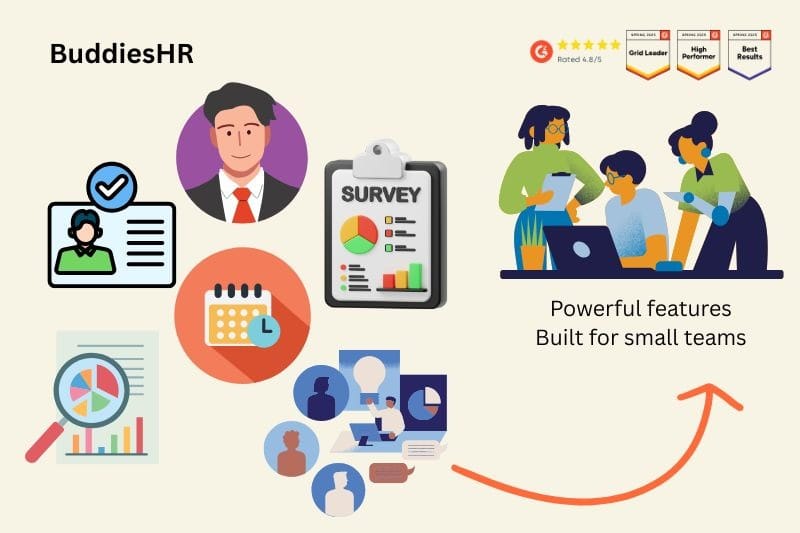How to use 360-degree feedback in performance reviews (and why it works)
Learn what 360-degree feedback is, the benefits, and why it works. Discover how to implement a smooth, bias-free process in your organization and automate it.

If you’re looking for an alternative to top-down performance feedback because you’ve realised it has major insufficiencies, then you’ve come to the right place.
A Gallup study found that only 26% of employees feel that the feedback they receive helps them to do better work. This means the majority of the workforce is not achieving their full potential in the workplace. The good news is: With better feedback, they could.
We discuss an alternative way to review performance in which all relevant stakeholders provide input on employee growth. Let’s start here 👇

Quick Overview
360-degree feedback is the process of collecting employee performance input from people who interact closely with someone’s work each day. This can be managers, peers, direct reports, and customers. When used correctly, it produces a balanced view of employees’ behavior and acts as the foundation for constructive feedback.
Table of Contents
- What is 360-degree feedback?
- Benefits of 360-degree feedback
- Why 360-degree feedback works
- When you should use 360-degree feedback and when to avoid it
- How to implement 360-degree feedback in your organization
- Final Thoughts
- FAQs: 360-degree feedback
What is 360-degree feedback?

360 degree feedback, also known as multi rater feedback, is a commonly used performance management tool. The tool is designed to gather feedback from multiple parties, known as feedback providers. These parties are in direct contact with an employee’s work, giving them the ability to provide honest feedback for professional development.1
From the feedback, the manager and employee can compile a development plan to address any gaps in performance. It is a great tool for developing a better understanding of behaviors, and since it is completed by more than one person, it helps to confirm any blind spots the employee may have about their work.
Further insights into performance reviews:
Benefits of 360-degree feedback
When implemented correctly, the strength of 360-degree feedback lies in its ability to cut through biased evaluations, ineffective managers, and individual employees' opinions. In a nutshell, it provides a clearer, broader picture of performance because it comes from different perspectives. With insight into the process, we can zone in on five key benefits of using 360-degree feedback.
- With extended use, it can facilitate the development of distinct talents and competencies.
- It has a transformative effect on behavior and habits as employees actively participate in self-improvement. Employee development is active, ongoing, and driven by fairness.
- It has the potential to enhance leadership skills among individuals in leadership positions and those poised to become leaders.
- Employees who regard their feedback as valuable to the organization's success are more likely to be engaged. They also experience greater satisfaction when their feedback leads to significant changes.
- During the course of employment, workers have the opportunity to foster greater self-awareness, which can lead to greater success at work and in life.
You might also like: Pros and cons of the 360 review process

Why 360-degree feedback works

Simply, it works for two powerful reasons: more data collection and greater perspective.
First, let’s deal with the data. Behavior is thought to be context-driven.2 A manager looks at the organization’s strategy. Peers look at collaboration, workflows, and day-to-day employee experience. Customers look at various aspects of the employee’s behavior. Direct reports see leadership skills. The combination tells you how the whole person operates.
Secondly, all humans overweigh their own interpretations. They concentrate on carefully selected information that they value. Multi-rater feedback introduces triangulation, explained by social scientists Cohen and Manion (2000) as follows:
‘An attempt to map out, or explain more fully, the richness and complexity of human behavior by studying it from more than one standpoint.’
When used by companies that value seeing the big picture, 360-degree feedback creates:
- Clear communication.
- Higher perception of fairness.
- Faster skill growth.
- Greater business results.
When you should use 360-degree feedback and when to avoid it

While the 360-degree feedback is a powerful tool for developing actionable feedback and helping employees understand themselves better, there are conditions under which the tool should not be used. Check whether your company qualifies to use 360-degree reviews.
When you should use it
- Your company values include transparency, fairness, and feedback from multiple perspectives.
- Employees collaborate with at least 3-4 different stakeholders in completing their job responsibilities.
- You’re shifting towards a strategy that measures behavior, and want to develop action plans for future growth.
- You want leadership development to be growth-focused, with the aid of survey results and upward feedback.
When you should avoid it
- Your management team is dealing with low levels of trust and buy-in for new initiatives.
- There is a major interpersonal conflict between teams or departments.
- Senior leaders or Human Resources are heavily against the process for valid reasons.
- People are very distrustful of anonymous feedback and feel that it will be used to ‘get even’.
- You will use 360-degree feedback for pay or promotion decisions without it forming a part of a greater performance management strategy.
Not yet ready for 360-degree feedback? Here, we offer advice on running great performance reviews for getting one step closer to your goal.
- Common mistakes employers make in a performance review
- How to prepare for a performance review as a manager
How to implement 360-degree feedback in your organization

A strong implementation plan supported by a strategic outlook and a clear definition of what you want to achieve with 360-degree feedback is necessary for the success of the process.
Get your first review live in minutes. 👉 Try performance review software by BuddiesHR.
Tools that make 360-degree feedback easier for everyone

Whether you’re a small company, a start-up, a remote working team, or a larger company, the fears are the same. ‘Will this be a huge task with multiple spreadsheets and more chaos?’
The answer is: No! Absolutely not. Modern performance review software like Simpleperf (BuddiesHR) provides the infrastructure to get your reviews done easily and effectively. They generate reports automatically and compile helpful insights from the collected data.

Why does automation of the 360-degree process work?
- Setup takes a few minutes to maybe a few hours, not weeks or months.
- You get sophisticated data collection and processing at a fraction of the cost charged by enterprise platforms.
- First-time managers can easily understand and run the process successfully.
- It’s not overwhelming. It's not complex.
- You only get relevant feedback with AI-generated insights.
- Smart reminders ensure you always have the feedback on time.
- You are guided from start to finish.
Ready to launch your first great 360-degree review? 👉 Create it now.
Conclusion
Under the right conditions, 360-degree feedback offers a balanced employee development tool, superior to the traditional top-down approach. Implementing a structured process has many benefits for your business and for the growth of your employees. With performance review software, any company can run this evaluation process and get good results. Why not take the first step right now? 💪 Start here.
FAQs: 360-degree feedback
1. What is 360-degree feedback?
360-degree feedback is an evaluation process in which an employee receives feedback from multiple sources, including a self-evaluation. It is a more comprehensive approach than traditional top-down employee feedback, in which only the manager provides input into the performance evaluation.
2. What is an example of good 360-degree feedback?
A good 360-degree feedback is specific, actionable, and balanced. It provides concrete examples instead of subjective opinions. This kind of feedback increases self-awareness and helps the employee see the gap between their intentions and observable behaviors.
3. What are the four parts of 360-degree feedback?
The four parts of a 360-degree feedback are: self-assessment, manager evaluation, peer assessment, and either direct reports or customer feedback. This provides an all-round view of the employee’s performance, which strengthens the feedback process.
4. How do I get 360-degree feedback?
First, define the objectives for the feedback, then choose a survey platform, and select a diverse group of respondents to participate in the survey. You should also develop a standard set of questions that pertain to the employee's job function or culture-specific behaviors you want to evaluate.

References:
1. (PDF) 360-Degree Feedback as a Tool for Improving Employee Performance
3. Cohen, L., Mansion, L. and Morrison, K. (2000). Research Methods in Education, 5th ed. London: Routledge. p.25




